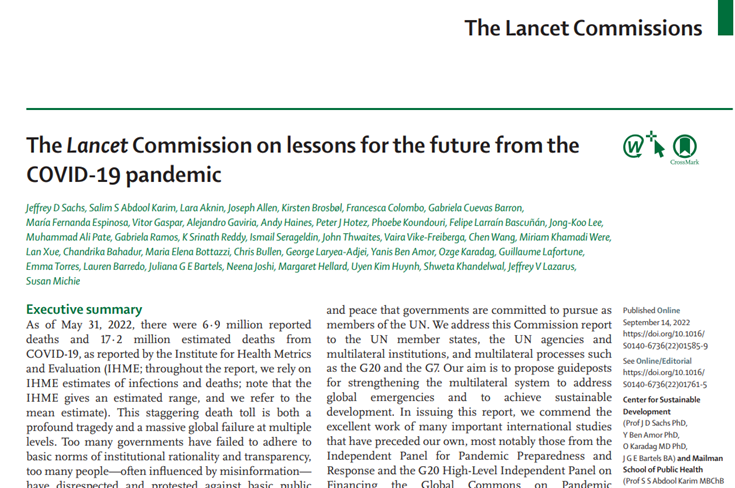
A thread from @TheLancet @CovidCommission on school closures:
--> 195 countries closed schools during the pandemic, affecting more than 1·5 billion children and young people and posing enormous long-term and unrecoverable costs to them, their parents, and the economy.
🧵1/n
--> 195 countries closed schools during the pandemic, affecting more than 1·5 billion children and young people and posing enormous long-term and unrecoverable costs to them, their parents, and the economy.
🧵1/n

--> School closures have had devastating effects on student learning, mental health, socioemotional outcomes, and lifetime earning potential, such as education backslides, increasing drop-out rates, and increased abuse and neglect.
2/n
2/n
--> In-person schooling was deprioritised even as other non-essential or less essential community and economic activities continued.care centres, schools, or universities.
3/n
3/n
--> School closures also affected the safety of children, increasing their exposure to abuse.
4/n
4/n
--> Lack of economic support at home and the lack of protection offered by schools affected girls in particular
5/n
5/n
--> increased risk of mental health problems, violence, child marriage, pregnancy, female genital mutilation, and HIV infection, with limited or no access to services
6/n
6/n
--> 11·2 million girls and young women globally are now at risk of not returning to care centres, schools, or universities
7/n
7/n
--> Across the United States and Mexico, at least 62 million elementary-age and secondary-school-age children (aged 5–18 years) were physically out of school for at least 13 months continuously.
8/n
8/n
--> In Latin America, more than 165 million young people stopped attending classes in person.
9/n
9/n
--> To deal with these school closures, the education sector pivoted to online learning and digital resources, immediately redefining access to learning by access to the internet.
10/n
10/n
--> As of December, 2020, 64% of low-income students in the United States were attending school solely via computer, compared with 48% of high-income students.
11/n
11/n
--> Black (66%) and Hispanic (64%) students were almost twice as likely as White (34%) students to be learning fully remotely, and were also twice as likely as White students who were also remote to have no live access to a teacher.
12/n
12/n
--> UNICEF estimates that a third of the world's schoolchildren were unable to access digital learning.
13/n
13/n
--> School closures have also affected children's physical health, food security, and nutritional status.
14/n
14/n
--> Since the beginning of the pandemic, UNESCO estimates that nearly 370M children across 50 countries have missed meals since school closures began, and that globally an estimated 39 billion in-school meals have been missed as a result of pandemic-induced school closures
15/n
15/n
--> An average of four in ten in-school meals have been missed by children around the world, and this number increases to as many as nine in ten in some countries.
16/n
16/n
--> The absence of a structured, school-led routine and peer interactions has disrupted the lives of children; amplified the anxiety caused by isolation and their fears of the disease; and led to the loss of physical, intellectual, and social engagement.
17/n
17/n
--> Motivation levels in children have declined because of the inability to play outdoors (which also affects their physical health), meet friends, and be in the classroom.
18/n
18/n
--> Globally, a median of one in five young people aged 15–24 years said that they often felt depressed or had little interest in doing things.
19/n
19/n
--> One estimate from the World Bank suggests that this generation of children could potentially lose an estimated $10 trillion globally in their life earnings.
20/n
20/n
--> The loss of learning could also potentially increase learning poverty levels to 63% and drive countries even further off-track from achieving their learning poverty goals.
30/n
30/n
--> The estimated economic loss for south Asia due to school closure is projected to be between $622 billion (best-case scenario) and $880 billion (worst-case scenario).
31/n
31/n
--> For 2020 alone, the IMF estimated learning losses from mandated school closures at 20–25% of the school year in advanced economies and twice that in emerging market and developing economies.
32/n
32/n
--> As the pandemic entered its third year, schools continued to impose stringent restrictions.
33/n
33/n
--> Although efforts should be made to reduce undue risk of infection to children, it should further be recognised that it is possible to keep schools open without putting students and adults at excessive risk.
34/n
34/n
--> Because of the lower risk of severe COVID-19 among children, and considering the harms of school closures, in-person learning should be prioritised.
35/n
thelancet.com/journals/lance…
35/n
thelancet.com/journals/lance…
• • •
Missing some Tweet in this thread? You can try to
force a refresh




